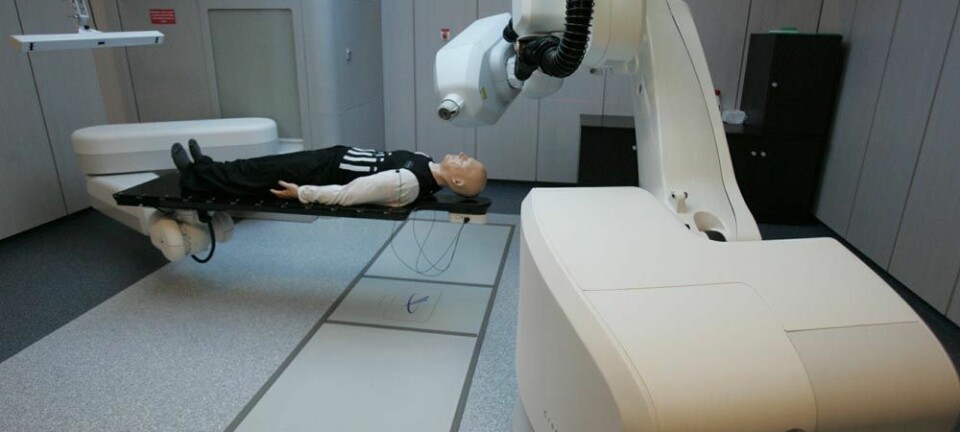An article from University of Oslo

Fat bubbles and ultrasound fight cancer
Cancer treatment is now more precise. Encapsulated chemotherapy strikes the dangerous tumor right on. Ultrasound spreads the poison in the cancer tissue.
Denne artikkelen er over ti år gammel og kan inneholde utdatert informasjon.
A common form of treatment for cancer is chemotherapy. But chemo doesn't always work as desired and can have serious adverse effects.
Researchers are now on the trail of a more targeted form of treatment that results in fewer side effects.
The answer lies in ultrasound. The use of ultrasound will make chemotherapy far more accurate. Such precision is worth its weight in gold.
"In traditional chemotherapy the chemo enters both healthy and diseased tissue," explains researcher Eirik Hagtvet.

He recently defended his thesis Liposomal drug delivery in multimodal cancer therapy at the Institute of Clinical Medicine, University of Oslo.
He says that when chemo is injected intravenously, it spreads throughout the body.
Consequently, the amount of chemo in the cancerous tumour is less than desired, while healthy tissue is inundated by high concentrations.
Fat bubbles as carriers
Side effects occur when the chemo accumulates in healthy tissue. Even though chemo might be effective against the tumour, it can cause side effects that are very unpleasant and even harmful.
"One strategy for improving the distribution of chemo is to pack it into tiny fat bubbles called liposomes," explains Hagtvet.
Liposomes are so large that they will not accumulate in healthy tissue, but will instead settle in even greater numbers in the cancerous tissue.
Consequently, more chemo gets inside the tumour and less in the healthy tissue. Just as desired.
After the liposomes have reached the tumour, the chemo needs to be released. This is where ultrasound enters the picture.
A car full of chemo
Hagtvet and colleagues make ultrasound-sensitive liposomes that burst when exposed to ultrasound.
So when the liposome reaches the tumour, ultrasound is used to release the chemo inside the tumour.
Hagtvet uses a car metaphor to illustrate the process.
"Imagine a car full of chemo. The car drives past nice, healthy tissues and stops in the right parking lot, where the cancerous tissue is located," explains Hagtvet. "Ultrasound opens up the doors of the car and disperses the chemo inside the tumour. The car delivers the chemo and the ultrasound releases it in the right place."
Encapsulating chemo in tiny fat bubbles has been done for many years. Using ultrasound to release the chemo, however, is entirely new.
According to Hagtvet ultrasound-sensitive liposomes give a much higher concentration of free chemo in the tumour.
They thus become tools for optimising the already existing form of treatment.
Mice as models
Hagtvet has used animal models to arrive at his findings.
When human cancer cells are injected into mice, tumour cells begin to grow on the back of the mice's thighs. These tumours appear because the mice have impaired immune systems.
This provides scientists with a model of a tumour in a human.
It is only a model and is not directly transferable to humans. It is therefore difficult both to estimate the exact effect the treatment will have on people and how long it will take before it can be used on people with cancer.
But the scientists have found some mechanisms, principles and concepts that show that it may be appropriate to use ultrasound in conjunction with the injection of chemo.
When is the treatment most effective?
The method must be used on solid tumours. It will therefore not be appropriate for a patient with metastasis.
"There must be a single tumour that has not metastasised, preferably early stage," emphasises Hagtvet.
In addition to being a targeted treatment method, this technology causes few side effects.
Which cancer patient taking chemotherapy would not dream of a course of treatment without nausea, vomiting, hair loss and impaired immune function?
Living with cancer
Cancer patients often have to choose between two evils. The treatment can cure, but can also cause terrible side and after-effects.
When surgery is performed it is sometimes necessary to remove tissue that has important functions. As a method, encapsulated chemotherapy does not entail a major surgical intervention. At the same time it causes fewer side effects than conventional chemotherapy.
"Life can go on even if you have been diagnosed with cancer," says Hagtvet.
"Because it's about being able to live even if you are sick."
------------------------------------------
Read this article in Norwegian at forskning.no


































